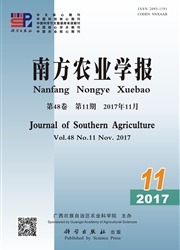

 中文摘要:
中文摘要:
【目的】获得鹅坦布苏病毒(GTMUV)E蛋白结构域III的原核表达重组蛋白并明确其免疫原性,为进一步研究其生物学功能及研制亚单位疫苗奠定基础。【方法】根据Gen Bank中GTMUV JS804株E蛋白结构域III的同源基因序列设计1对引物,在其两端加入Flag标签序列和酶切位点,采用PCR扩增GTMUV的E蛋白结构域III基因(EIII),然后与p ET32a原核表达载体连接构建重组表达质粒,转化大肠杆菌BL21(DE3)后用IPTG诱导融合蛋白表达,并以Western blotting鉴定其免疫原性。【结果】PCR扩增获得携带Flag标签序列的EIII基因片段约430 bp,将其插入p ET32a载体可成功构建重组质粒p ET32a-EIII。阳性重组菌经IPTG诱导表达5 h即可得到融合蛋白,分子质量约33.0 k Da,主要以包涵体形式存在。Western blotting鉴定结果显示,融合蛋白与抗Flag标签单克隆抗体、小鼠抗坦布苏病毒多克隆抗体均可发生特异性反应,检测到预期的目的条带。【结论】GTMUV E蛋白结构域Ⅲ能在大肠杆菌中成功诱导表达,且获得的融合蛋白具有良好的免疫原性,可用于研制GTMUV诊断抗原和亚单位疫苗。
 英文摘要:
英文摘要:
[Objective]The prokaryotic expression and immunogenicity of goose tembusu virus(GTMUV) E protein domain III were identified in order to lay the foundation for further researches on the biological function and subunit vaccine development of E protein domain III in GTMUV. [Method]According to homologous gene of E protein domain III in GTMUV JS804 strain from GenBank, a pair of primers with Flag tag sequence and enzyme digestion sites at both ends was designed to amplify E protein domain III gene(EIII) by using PCR technique. The PCR product(EIII) was in- serted into prokaryotie expression vector pET32a to construct recombinant expression plasmid which then was transformed into E. coli BI221 (DE3). Through induction with IPTG, the fusion protein was expressed in order to identify its immunoreactivity by using Western blotting. [ Result ]The obtained EIII gene fragment with Flag tag sequence was about 430 bp in length by PCR amplification and then inserted into pET32a to construct expression plasmid pET32a- EIII successfully. The positive recombinant strain was induced with IPTG for 5 h, the expressed fusion protein existed as inclusion body in E. coli and the molecular weight was about 33.0 kD. The identification results of Western blotting showed that fusion protein could react specifically with Flag McAb and mouse PcAh against tembusu virus to detect out target bands. [Conclusion]The E protein domain III of GTMUV can be successfully expressed in E.coli BL21 (DE3), and the obtained fusion protein has good immunogenicity. Therefore, it can be used for development of GTMUV diagnostic antigen and subunit vaccine.
 同期刊论文项目
同期刊论文项目
 同项目期刊论文
同项目期刊论文
 Protective immune response against newly emerging goose tembusu virus infection induced by immunizat
Protective immune response against newly emerging goose tembusu virus infection induced by immunizat 期刊信息
期刊信息
